For thousands of years, humans have recorded and documented history, stories, and their life experiences. These written records have transformed from cave wall drawings and papyrus scrolls to printed novels and Kindle books. With the transformation of the written word, the methods of destruction have also evolved. Let’s dive into some of the history of data destruction methods and some of the key players involved.
4000 B.C. Egypt: The Invention of Papyrus
Papyrus, the world’s first ever form of paper, was invented in ancient Egypt thousands of years ago in approximately 4,000 B.C. People began using it to document history, life events, news, and stories. With the inception of recorded information came the need to destroy that information, whether to prevent confidential information from being stolen or placed into the wrong hands or destroying information that was deemed inappropriate or blasphemous. When the need for destruction would arise, without modern day shredding technology, people were forced to resort to manual destruction of papyrus scrolls. Fire was also a viable option to destroy recorded information, as seen in the 48 B.C. destruction of the Royal Library of Alexandria and its loss of 500,000 scrolls’ worth of recorded history.
1909 New York City: Abbot Augustus Low’s Paper Shredder Patent
New York City-based inventor Abbot Augustus Low is known for his invention of the first ever paper shredder in 1909. Unfortunately, Low passed away shortly after filing the shredder’s patent and was unable to manufacture it beyond just an initial prototype. His invention was primarily intended to be used in banks and counting houses.
1935-1959 Germany: From Pasta to Particles
It wasn’t until thirty years later in 1935 when the paper shredder was actually first manufactured. Adolf Ehinger created the first real paper shredder as a matter of life or death; at the time, he was living in Nazi Germany and was being questioned about the anti-Nazi literature in his garbage. Ehinger created a paper shredder that mimicked a hand-cranked pasta maker to destroy the literature and was able to successfully avoid persecution.
After this incident, Ehinger added an electric motor to his paper shredder which he was able to market and sell throughout the Cold War in the 1950s. Once his machine quickly started gaining popularity, his company, EBA Maschinenfabrik, crafted the first cross-cut paper shredder. This newer model not only shredded the documents into strips, but also sliced them into smaller pieces similar to confetti to ensure extra security.

1940s: The World’s First Degausser
After the introduction of iron ships in the late 1800s, scientists and crew members soon discovered that iron had an interesting effect on compasses and magnetic fields. It wouldn’t be until decades later when they would use this information to create the first ever magnetic degausser.
Decades later during the early days of World War II, Canadian chemist Charles F. Goodeve was working for the British Royal Navy researching methods to disarm war mines. In 1939, a British naval shore was targeted by a German mine that, luckily, had been disarmed before causing any harm. After conducting research on the now disarmed mine, Goodeve and his team were able to discover that the mines were equipped with triggers that would detonate based on the surrounding gauss level. A gauss level, named after scientist and mathematician Carl Friedrich Gauss, is a unit for measuring magnetic density. This discovery was major news back then as the British Navy was able to install electrical cables lining the circumference of their ships that would carry an electrical current, ultimately neutralizing the ship’s magnetic field. This first act of degaussing allowed the British naval ships to remain completely undetected by the Germans and enemy mines. It was this revolutionary technology that has led to modern-day degaussing of tapes and other magnetic devices.
1968: The Inception of Security Engineered Machinery
Korean War veteran and SEM founder Leonard Rosen created the first ever paper disintegrator in 1968 after the infamous Pueblo Incident. The Pueblo Incident occurred on January 23, 1968 when the USS Pueblo, a U.S. Navy intelligence vessel, was intercepted by North Korean patrol boats. In an act of desperation to protect national secrets, the Pueblo crew members began furiously trying to destroy the onboard classified information. Unfortunately, the crew was unsuccessful in their mission and were forced to surrender, leaving their attackers with free reign over the remaining documents.
In comes Leonard Rosen. This incident didn’t sit well with Mr. Rosen, a Korean War Veteran, who began to draft a better paper destruction method specifically for confidential and classified information. Within a matter of a few weeks, he had created the world’s first paper disintegrator. What makes the disintegrator different and more secure than a paper shredder is that it uses a repeating knife chopping process and screen that the particles must pass through. Disintegrator particles pass through the sizing screen in irregular shapes, sizes, and orientations and fill the waste chambers at different times, all of which makes it much more difficult to piece the now destroyed records back together.

Since 1968, data destruction methods have only become increasingly more advanced and secure. The commodified use of paper shredders has transformed from being solely in government buildings to now virtually every place of business and personal homes. Shredders have steadily gained popularity over the years due to infamous incidents like the Watergate Scandal in 1973 and the Iranian Embassy siege in 1979, and are now equipped to shred magnetic drives and other forms of optical media.
For over 50 years, SEM has been the driving force behind innovative data destruction methods and has laid the groundwork for end-of-life best practices. Today, we are the industry leader for electronic media crushers and shredders, and have data destruction equipment in every U.S. embassy, military base, naval ship, and government building across the globe. We know that the best way to protect federal and personal information is to conduct all end-of-life data destruction in-house with SEM’s state-of-the-art destruction equipment.

